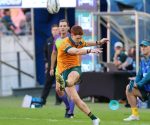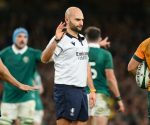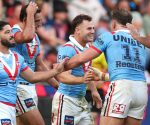Footy Fix: The Blues are a second-half shambles
Here’s a fun fact everyone but Carlton supporters can enjoy: the Blues have never, in 129 years of VFL/AFL football, lost four consecutive games having led at half time.
These are unprecedented times for a football club kind of used to being historically bad over the last two decades – and it’s honestly impressive they’ve found a new depth to plumb.
And you’d honestly be hard-pressed to recall a more debilitating month of football for Blues fans. In two of those four matches, they’ve been utterly dominant in the first half, and mincemeat in the rest, against the might of Richmond and a Marcus Bontempelli-less Western Bulldogs. And in the other two, they have gone toe to toe, and even shaded for points, two likely contenders in Hawthorn and Collingwood, and been fatally overrun within minutes of the first bounce of the second half.
The Blues are a second-half shambles. And it’s worth trying to figure out why, how, and what they can try to fix it.
It’s surely spurious to say it’s entirely a fitness problem – and frankly, smacks of shallow analysis when their opposition is the oldest side ever put to an AFL field and was copping flak for their own vigour less than a month ago.
Instead, the Blues’ issues are part tactical, part decision-making: they both tie into fitness, but there’s more to be done to fix those problems than simply working a bit harder at training.
The raw stats tell of the carnage – having amassed 51 more disposals, been virtually level on the clearance count, won 11 more contested possessions and 23 more marks to half time, the Blues saw their domination entirely flipped on its head.
Third quarter disposals? 95-62, and it honestly felt like more. +7 in clearances, +10 in contested possessions. 17 inside 50s to just seven. And crucially, 24 Magpie marks to just 10 from Carlton – six of those Pies grabs inside 50, to zip.
And the kicker: Nick Daicos, 10 disposals and zero effective kicks to half time under a tight George Hewett tag, nine disposals, eight of them effective, in the third term alone.
So what changed? Well, paradoxically, nothing about Carlton’s game altered after half time – and that was the problem. Because Craig McRae and the Pies identified their issues, deciphered how the Blues had been controlling the game from stoppages and using it to stymy the Pies’ ball movement, and took steps to fix it.
The Blues’ first half avenue to goal was a straightforward one: once the footy is won, move it quickly, through the corridor if possible, and link up with handball rather than blaze away.
Their first goal of the night saw Ollie Hollands capitalise on exactly this kind of overlap running, leaving the Pies’ defence unable to set up to stop a ball coming directly at them in full motion rather than high and long for them to mop up.
Ditto the second: an intelligent Adam Cerra kick inboard from defensive 50, stream running forward via a series of clunky but ultimately good enough handballs, and then Patrick Cripps, all by himself in space in attacking 50, drilling a goal.
If using the corridor was key, then giving to the passing runners was an obvious message of the week from Michael Voss: 40 metres from goal directly in front, Brodie Kemp is well within his rights to take a set shot for the Blues’ fourth goal, but instead does what he has been instructed to do and handpass to an onrushing George Hewett, who does the rest.
It wasn’t always perfect, but it was dangerous, daring play, with enough pressure on the Magpies going the other way to give the Blues’ backline time to get back and neutralise contests aplenty. To keep the Pies’ multi-faceted attack to just four first-half goals from 26 inside 50s was an impressive effort.
But after half time, the Pies changed a couple of elements: how they defended that handball game, and also how they structured around the ball in general. And the Blues simply couldn’t cope.
For ball-ups and boundary throw-ins, the Pies stacked the contest – denying the Blues the space they needed to get their handball game from the inside of the contest into open space.
Compare this boundary throw-in at half-forward for the Magpies in the first quarter, with three direct midfield pairs, a loose at the drop zone (Harry Perryman) and a few wider floaters on both sides…

… to the first boundary throw-in, in a near-identical spot on the other side of the ground, to start the third quarter:

There are now five pairs, all with close tabs on their opponents, and all competing directly under where the throw-in will drop – it’s going to be hard for the Blues to break away with anything more meaningful than a long bomb to a forward line with only an underdone Charlie Curnow as a high-marking target.
As it transpires, the Pies win the clearance, get it inside 50, and while Adam Saad repels, his kick, under hefty pressure, sails out on the full. A big Magpie win, with the repeat entry leading directly to the go-ahead goal.
The Blues’ ability to handball through the Pies’ press vanished in the third quarter, as did any semblance of control at stoppages. With more bodies around the contest, it was the Magpies who began to dictate terms, either winning the ball outright or ferociously tackling the Blue with first hands on the ball, leading to a spillage and turnover or ball-up.
Equally significant was how, on the rare occasions the Blues did get a run-on, the Pies’ defence refused to be sucked into the ball-carrier.
Take this run, up the centre, midway through the term:

It’s the Blues’ first significant centre bounce takeaway of the quarter, and as Lachie Fogarty looks up, he has two immediate handpass options: Jesse Motlop to his left and Brodie Kemp over the top. Only Isaac Quaynor stands in his way.
In Cripps’ first-quarter goal, Brayden Maynard had played right into the Blues’ hands – abandoning the captain, he rushed at the ball-carrier, was unable to impact, and two easy handpasses later Cripps ran into an open goal.
This time, though, Quaynor isn’t sucked up – he literally stays still, letting Fogarty come to him. It works perfectly – Fogarty stutters, thinking first to kick, and by the time he’s decided to try and handball over the top, he’s closed in enough on Quaynor for the Pie to leap, smother the pass, and force a turnover.

These changes are minimal – they’re not colossal tweaks to the gameplan, or shifting players from one end to another, or a tag.
And equally, the Blues’ issue isn’t fitness – it’s their inability to tweak anything of their own in order to respond.
Without the ability to shift the ball to the outside, the Blues’ external runners suffered: Blake Acres, prolific with 19 disposals to half time, didn’t have another kick until the 7-minute mark of the final quarter; ditto Adam Saad – 14 kicks in the first half, just four in the second (and I’m fairly sure two were kick-ins).
It also left them with little hope of actually scoring until the game was all but over – they mustered just one behind in the third, and it took until the 13-minute mark of the last for another major to be scored.
In grim times like this, with scoring avenues dried up, with an opposition midfield on top, Voss has always had an ace up his sleeve.
Which brings me to the final problem with the Blues at the moment: what on earth is going wrong with Patrick Cripps?
A two-time Brownlow Medallist since Voss took the reins, Cripps is the man to step up when everything else is going dismally for Carlton.
He averages well over seven clearances a game since the start of 2022; in more than a third of his games in navy blue in that time period, he’s been best afield according to the umpires.
After being invisible against the Bulldogs last week when the match was on the line, his final three quarters on Thursday night are surely the quietest of his career when he’s played a full game.
11 disposals. One tackle. ONE clearance – that latter stat his lowest since 2019. Yikes.
It seems the Blues know he’s struggling, too: regularly given the task of jostling with Nick Daicos at stoppages, Cripps did at least help limit his influence, but that’s a job you’d usually give to George Hewett if you were comfortable with how your best midfielder was going.
Cripps is the only Blue in that ostensibly star-studded midfield capable of winning positive clearances from neutral contests – that is to say, turning a ball-up or lost clearance into a meaningful territory gain for the Blues. Walsh runs all day and Hewett battles manfully, but at stoppages, they can’t match what the skipper does.

Cripps’ bodywork is as good as ever: he shunts Scott Pendlebury under the ball, giving him a second of clear space with the footy. That’s usually enough: from here, he can give to Blake Acres, already starting to run for a handball receive, or go inboard to Tom de Koning, or if he’s really feeling it, barge past Steele Sidebottom and kick.
Instead, he fumbles. And suddenly desperate, rather than go for another crack, he soccers it forward, straight to the sweeping Dan Houston, and the moment is past.
Cripps doesn’t do that at his best.
Yet sometimes the greats reflect their teams when they’re struggling; and at the moment, Carlton’s woes couldn’t be better summed up by their captain. This is a team in dire straits, suffocated by the slightest change of tacks from the opposition, and looking dangerously like their best shot at true success has come and gone.
Only time will tell if they can fix it – because the one thing still on the Blues’ side at the moment is they have 19 games to turn this ship around.










